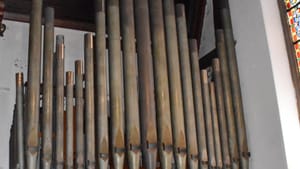Stay in the Loop
BSR publishes on a weekly schedule, with an email newsletter every Wednesday and Thursday morning. There’s no paywall, and subscribing is always free.
Organ-ized support
The Playing and Preserving project aims to save Philly’s endangered historic organs

The Organ Historical Society has estimated that almost 50 percent of the historic organs in Philadelphia are unplayable or in a serious state of decay. But with the new Playing and Preserving initiative from Partners for Sacred Places and local music organizations, Philly hopes to reverse this trend.
Partners for Sacred Places is a nonprofit, nonsectarian organization founded in 1989, which helps congregations of historic sacred places throughout the country enhance their roles as community anchors and develop their own strategies for their future survival. Now, Partners has launched Playing and Preserving, coordinated by community engagement and services director Joshua Castaño, to save the historic organs of Philadelphia.
Getting started
The project began when organ performance students from the Curtis Institute of Music filled out a survey on 50 historic organs. Castaño contacted Astral Artists, a national organization that helps develop the careers of extraordinary classical musicians, to organize a series of performances at St. Mary’s, Hamilton Village (an episcopal church on the University of Pennsylvania’s campus), featuring its 1937 Aeolian-Skinner Opus 963 organ, one of 10 historic organs selected for this year’s projects.
In turn, Astral chose Play on Philly (POP) as its performance partner. POP has been providing after-school music education to Philadelphia children who’d otherwise lack access since it was founded in 2011 by Stanford Thompson, a Curtis graduate. The Astral artists involved in the project are serving as artist mentors to the POP students in preparation for three pilot concerts. The Astral artists involved are cellist Thomas Mesa, mezzo-soprano Chrystal E. Williams, and Project Fusion Saxophone Quartet.
Involving the kids
I visited an after-school coaching session led by Astral Artist Matt Evans, a member of Project Fusion. Evans, also a member of the United States Army Band (known as “Pershing’s Own”) and a gifted teacher, managed to get the young musicians to concentrate on the music for almost two hours after a full day of school.
Evans has not only taken time to work with the students, but has created an arrangement of the Johann Sebastian Bach chorale, Durch Adams Fall, for the POP wind ensemble, tailored to the young wind players. During the session I observed, he prepared the students for the formal procedures of the concert, mimicking the conductor as he raised his hands before starting the piece, showing them their signal to raise their instruments and be ready to play. In doing so, he is keeping the POP tradition of teaching not only notes, but every aspect of musical performance.

It takes a village
The coaching sessions are but a small part of this massive project. Michael Lawrence, organist and music director of St. Mary’s, Hamilton Village, will play the organ for the first of the project’s three performances. Lawrence praises the congregation, calling them “extremely supportive of the music.” He is part of the Partners team who is attending workshops and is the on-site person who maintains this historic organ. The rector of St. Mary’s, the Reverend Mariclair Partee Carlsen, has also fully embraced the project with Partners. “Our responsibility is to be stewards of the space,” she told me.
As the congregation raises funds to preserve the instrument at St. Mary’s, Hamilton Village, they will be leading the way to saving a historic organ in this innovative effort. With almost half of Philly’s historic organs in danger of falling silent forever, it’s an important step in preserving our musical history.
The three performances at St. Mary’s, Hamilton Village (near 39th and Locust Streets) are free and open to the public, and families with children are encouraged to attend. The concerts will all feature informal experience stations open 30 minutes before the performance, where visitors can talk with musicians, see videos of various organs, and hear recordings of different historic instruments. At the concert, the audience will also hear world-class artists play alongside the young musicians they have mentored. The first pilot concert is coming up on Friday, October 25, 2019.
What, When, Where
The Playing and Preserving project will present three concerts at St. Mary’s Episcopal Church, Hamilton Village. The first is Friday, October 25, 2019 at 6pm with Project Fusion Saxophone Quartet; Michael Lawrence, organ; and the Play on Philly Wind Ensemble. On Friday, November 22, 2019 at 6pm, hear Thomas Mesa, cello; Greg Zelek, organ; and the Play on Philly Cello Ensemble. On Saturday, December 21, 2019, at 2pm, hear Thomas Mesa, cello; Greg Zelek, organ; Chrystal E. Williams, mezzo-soprano; and the Play on Philly Symphony Orchestra and Choir. St. Mary’s, Hamilton Village is located at 3916 Locust Walk, Philadelphia. (215) 386-3916 or www.stmarysatpenn.org.
St. Mary's is wheelchair-accessible via an entrance at the back of the building.
Sign up for our newsletter
All of the week's new articles, all in one place. Sign up for the free weekly BSR newsletters, and don't miss a conversation.
 Margaret Darby
Margaret Darby